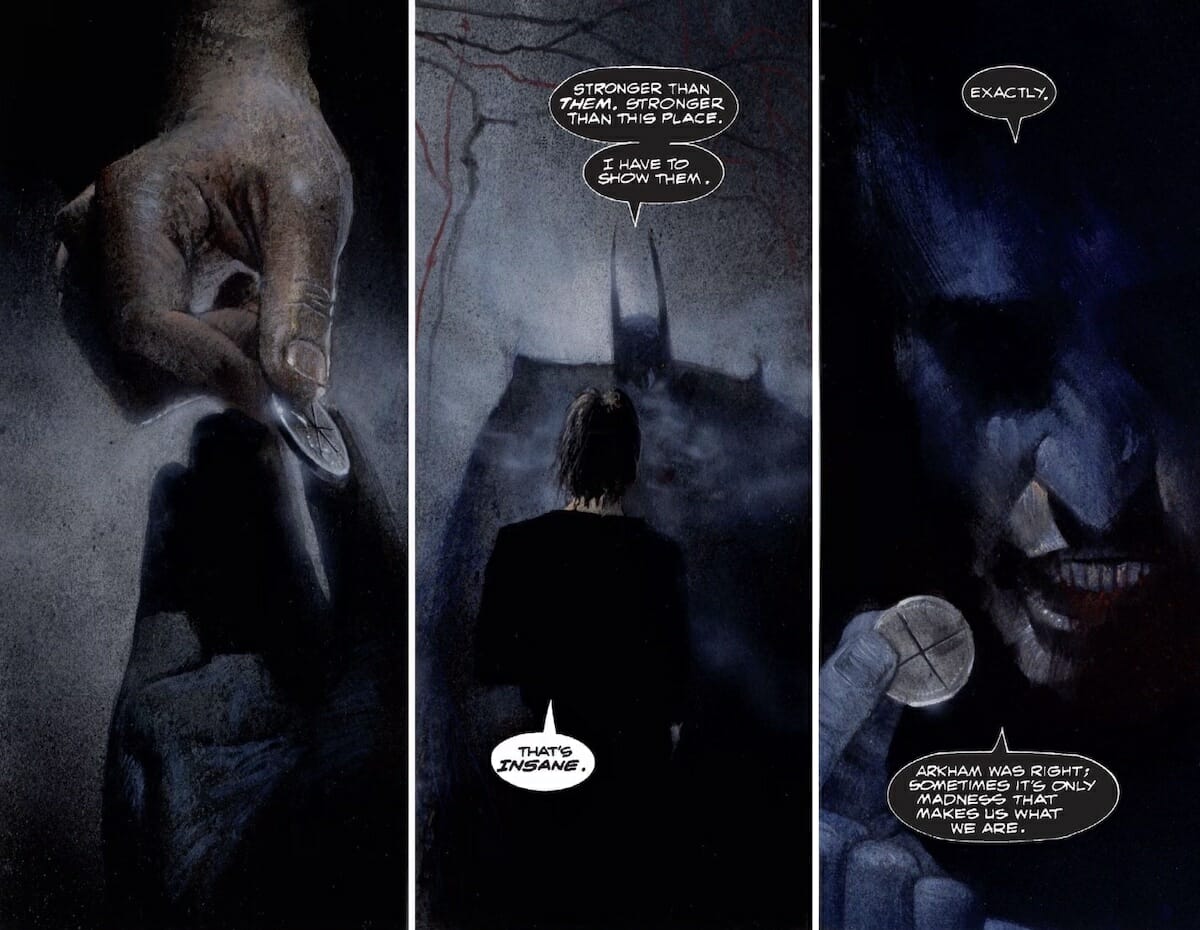There’s an old joke, forever circulating, that the story of Batman is one of a billionaire beating up the mentally ill. After all, in our world those with mental illnesses are much more likely to be the victims of violence than the perpetrators of it.
The villains of the Batman mythos aren’t simply “sick”. They dress up in costumes and taunt authorities with clues and kill innocents at whim. That’s why it struck me as noticeable when, in the Detective Comics Annual #1 (2021), Batman’s ex-sidekick Nightwing made a plea to his mentor to treat unwell citizens with more compassion.
This made me wonder: what’s it like to have a mood disorder in Gotham City? I’ve spent years on a losing scrabble hand of various SSRIs and SNRIs, tricyclics and salts, attempting to combat a long-term, drug-resistant depression. It’s tiresome at best, living with a sluggish parade of side-effects. Often it’s the worst day of your life, every day of your life.
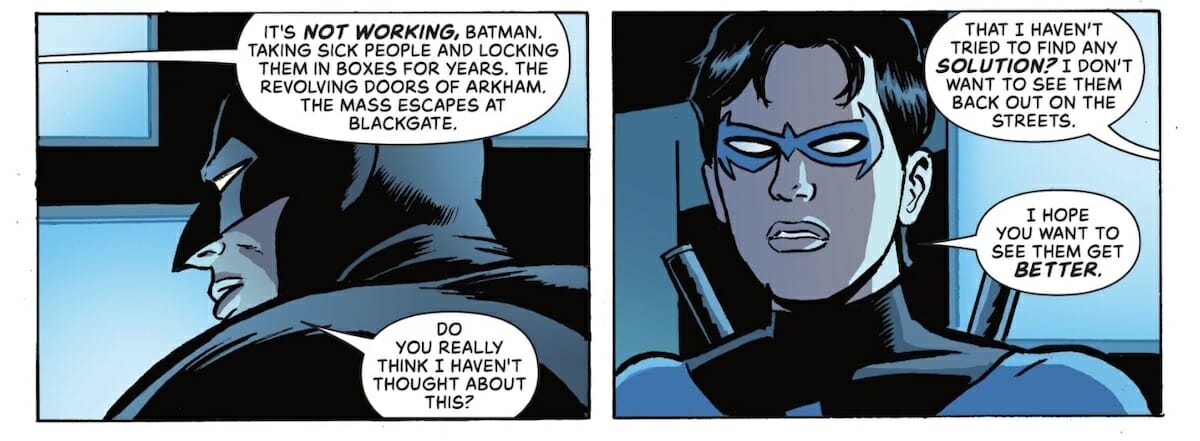
If Steinbeck’s poor Americans think of themselves as temporarily embarrassed millionaires, do Gotham’s mad think of themselves as temporarily restrained supervillains? Would I be only one missed dose away from dressing in purple and robbing a bank? I used to keep my struggles with mental health quiet, but the logic of comic books requires them to be sewn into your costume or tattooed onto your skin.
When he was asked to show more compassion, Batman told Nightwing: “We do what we can here. We aren’t the cure for the sickness in this city, but we can treat the symptoms.” The old joke echoes again, and with it the echoing biffs and pows and thwacks. Batman could be reducing the living, breathing men and women into simple symptoms of a larger madness.
believe, however, that he means “treating the symptoms” as responding to the actions of the unwell, not the unwell themselves. It’s only what they do that’s of interest in these stories. In “The Last Arkham”, beginning in Shadow of the Bat #1 (1992), we meet the psychiatrist Jeremiah Arkham who believes in something like behaviorism – that only what his inmates do matters. “The mind is such a bore,” he says, “a sparkling, glittering, total distraction!”
Superhero comics’ aversion to interiority suggests he might be onto something. Speeches and soliloquies are nice enough, but it’s only action that matters. That’s what comics demand above all else. The medium itself, of still images, chained together, requires that we turn potential energy into kinetic energy.
Depression is the opposite. In the language of Apokolips, it’s Anti-Life. I think that’s one of the reasons why I’m drawn to these larger-than-life stories of heroes and villains, because say what you will about them – they’re simplistic, hyperbolic, ridiculous – but their characters radiate an energy that I rarely feel in my daily life. If it means witnessing the mentally ill be demonized on a monthly basis, it’s a price I’m obviously willing to pay.
Frank Miller, author of The Dark Knight Returns (1986), once said that “Batman works best in a society that’s gone to hell”, adding: “That’s the only way he’s ever worked.” That’s why Gotham City magnifies a mood disorder into a murder; mental illness into capital-K Krazy. Years of comic books have taught me how origin stories function. They’re a single moment that defines who you are – the only thing separating me from criminal psychosis is one bad day.
That’s ultimately the premise of The Killing Joke (1988). The Joker tries to prove to Commissioner Gordon that all that separates sanity from madness is that bad day. He shoots his daughter, Barbara; he strips Gordon naked; he drags him through a hellish funhouse. Gordon manages to keep his sanity – and proves it by refusing to kill the Joker for his crimes. If Gordon had already struggled with mental illness, though? The story might’ve ended differently.
It’s not as though it’s easy to seek help in Gotham. Its therapists might mean well, but they’re utterly ineffectual. Take the graphic novel Arkham Asylum: Serious House on Serious Earth (1989): in it, there are seemingly well-meaning attempts to help the asylum’s inmates. Two-Face is weaned from the coin he flips to make decisions onto a tarot deck; two sides of a coin become 78 cards. However, this leaves him paralyzed with choice, unable to even make it to the bathroom.
And if therapists aren’t useless, they’re evil. Bryan Talbot’s two-parter “Masks” (Legends of the Dark Knight #39-40, 1992) features a villainous therapist who tries to break Batman’s spirit by convincing him there was never a Batman at all – just the delusions of a drunk. “What we’ve got here is classic hysterical neurosis, what we call hysterical dissociative phenomena. Long words, huh?” The true nightmare of any superhero is that all their action-packed adventures actually occurred while they were lying in bed, staring at the ceiling.
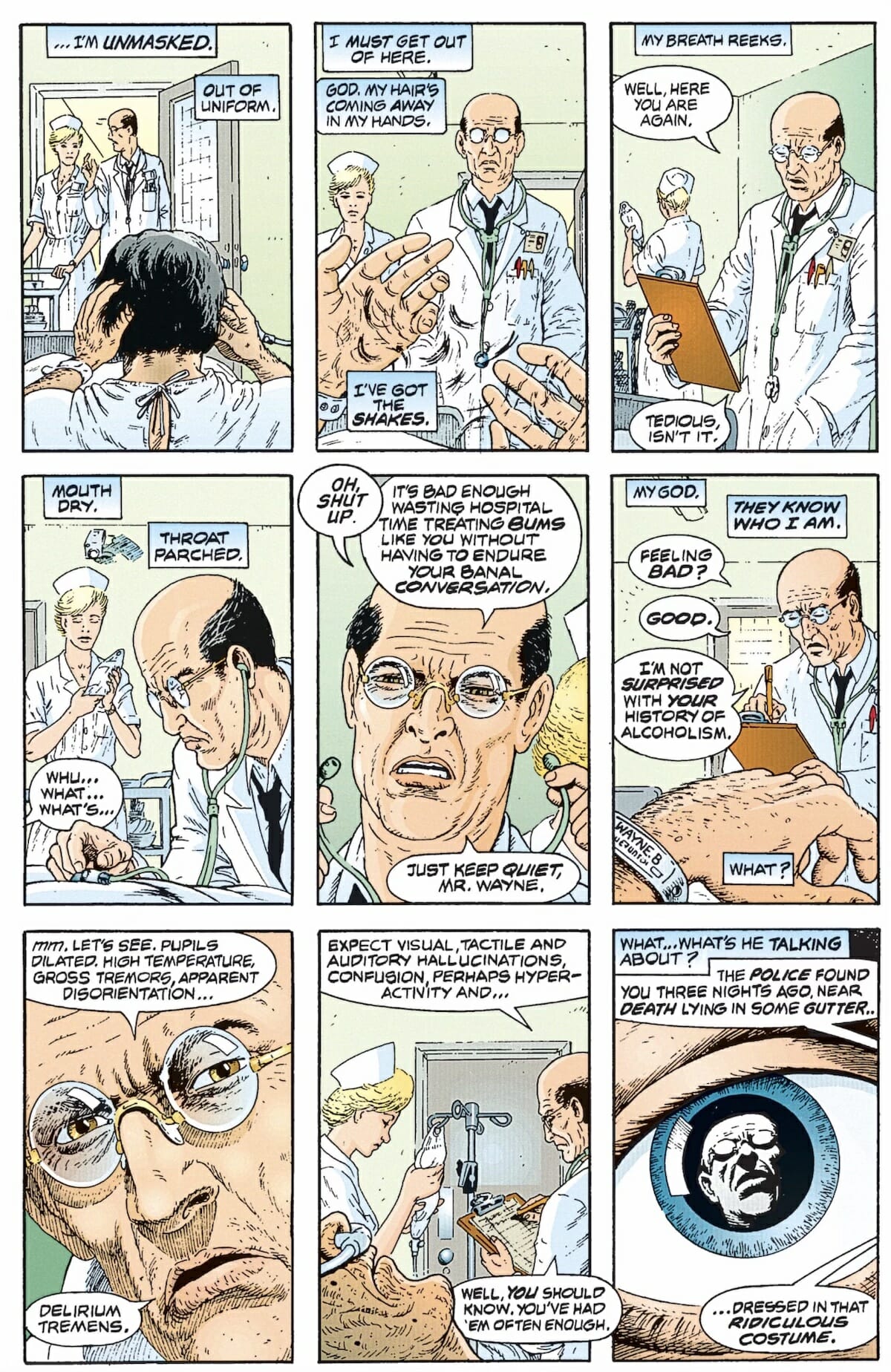
The image of Batman’s supposedly “real” costume – a ratty, homemade thing he’s told that he’s been wearing all along – is surprisingly potent. Is that how we appear to others? So different from how we see ourselves? It would be a relief not to care anymore. In Arkham Asylum, the therapist describes the Joker as perhaps possessing a kind of “super-sanity”.
The Joker and his ilk represent a kind of freedom, and Batman its opposite. In The Killing Joke, the Joker says to Batman: “You had a bad day, and it drove you as crazy as everyone else! Only you won’t admit it! You have to keep pretending that life makes sense…” In essence, then, the Joker is telling you to stop taking your meds.
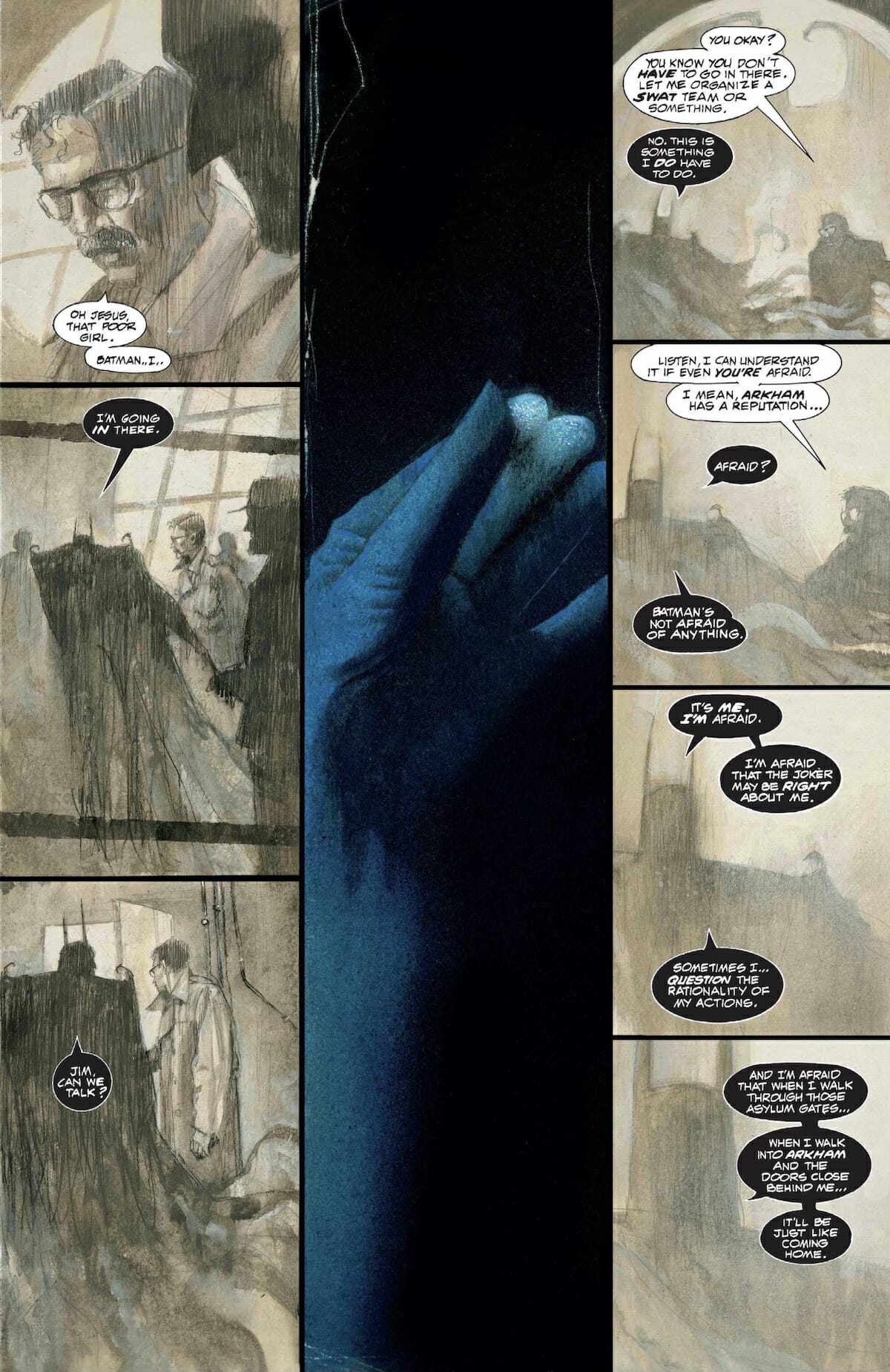
I’ve lost count of the comics, over the years, that have portrayed being on psychiatric medication in dull black-and-white. It taps into the ever-present urge to stop taking them: sometimes because you feel better, so figure you don’t need them anymore; sometimes it’s because you feel worse, so why bother taking them at all? And sometimes it’s because you convince yourself they’re a kind of prison, preventing you from seeing the world in color.
But Batman’s speech to Superman in The Dark Knight Returns (1986) is more of a mission statement: “My parents taught me a different lesson… lying on this street… shaking in deep shock… dying for no reason at all. They showed me that the world only makes sense when you force it to.” Arkham Asylum shows Batman plunging a shard of glass through his hand, trying to focus his mind through blinding pain. It makes sense if you force it to.
Batman: The 10 Cent Adventure, back in 2002, told readers that Batman’s “life is a series of tragedies…” That’s because his mission is one that can never succeed. Instead, it requires him to fight to keep order, night after night, issue after issue. Gotham is a place where nothing – and no one – ever gets better. At least not for long.
The story “Two of a Kind” from Batman: Black and White #1 (1996), cures Two-Face with a radical combination of plastic surgery and psychotherapy. But tragedy ensues, he burns off half his face, and again becomes a murderer. Then he waits for Batman to come and “take me back to where I belong… with the rest of the crazy people.”
Where he belongs is Arkham Asylum. Whenever Batman catches one of his enemies, they’re dutifully shoved into an Arkham cell and, in time, just as dutifully escape. One inmate, in Detective Comics #1046 (2012), says Arkham is “just a meat grinder… and we were the meat.” Its famous “revolving doors” mean there are always fresh foes for Batman to fight, back on the street, crazy as ever.
In “Going Sane” (Legends of the Dark Knight #65-68, 1994) the Joker believes he has finally killed Batman and almost immediately recovers his sanity. He fixes his face. Gets an apartment. Falls in love. Even the font used for his narration turns from jagged lines to regular all-caps. (The Joker’s words are often depicted differently than everyone else’s in comic books. In Arkham Asylum, the lettering turns them to bleeding chicken-scratch, weaponised against the reader. So much for the “talking cure”.) Batman’s not dead, of course, so the Joker loses his mind once more.
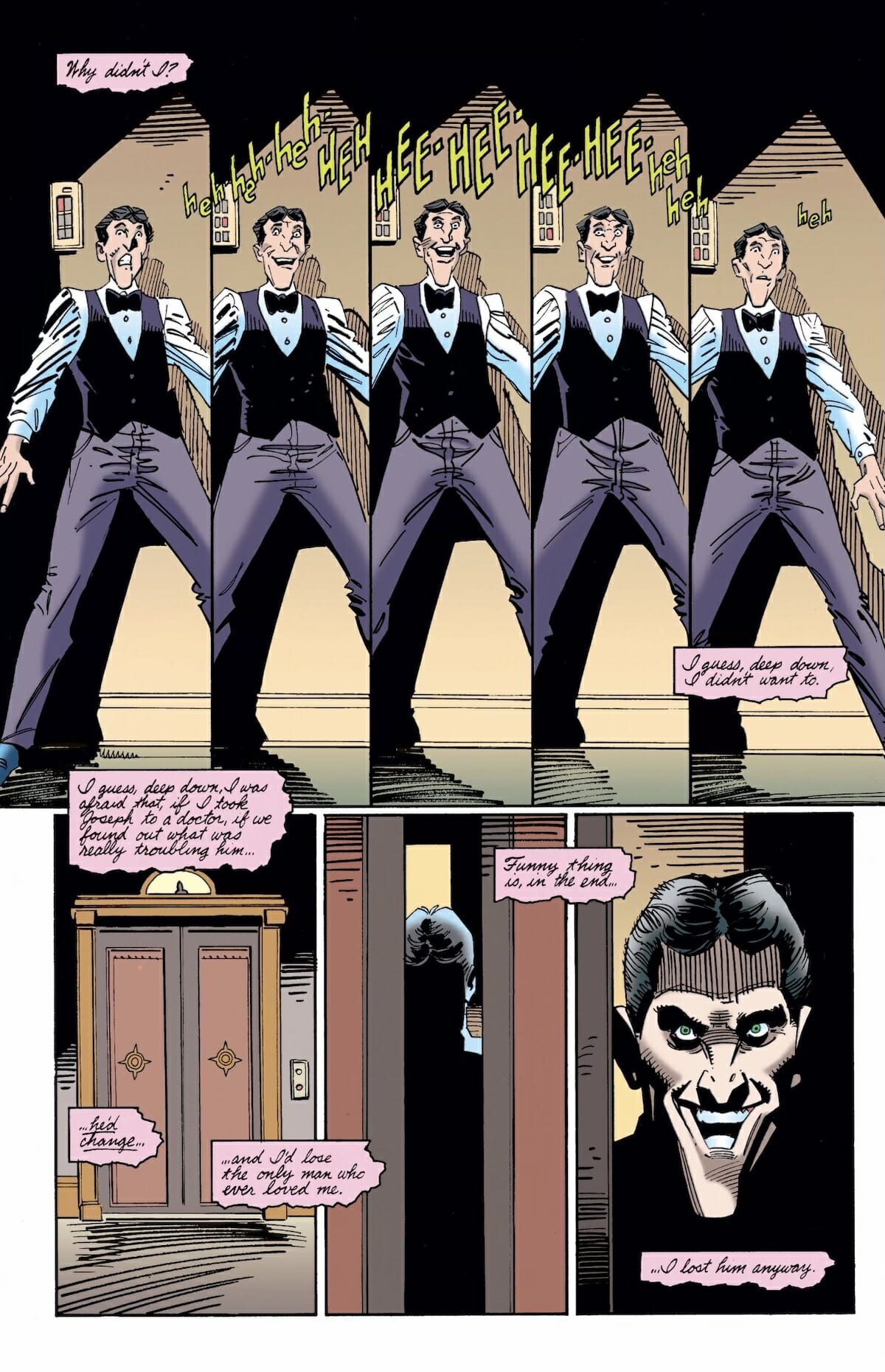
He has to: he’s needed for more stories. The door revolves once more. Maintaining your sanity has its own status quo. Staring at a handful of pills, I find it impossible not to do the sums. How many I need in a month. How many in a year. The colorful mountain of pharmaceutics required just to keep me on earth. I will probably never be “cured”; I’m not even sure what that would look like. Most stories – books, movies, whatever – struggle to represent this fact. Superhero comics that have run for decades, however, are uniquely positioned to capture its endlessness.
The ending of The Killing Joke is often read as ambiguous. Batman captures the Joker; the Joker tells him a joke; they both begin to laugh, Batman grabbing Joker by the shoulders. The ambiguity is in whether Batman kills the Joker by snapping his neck and silencing the laughter. It’s an interpretation promoted by Arkham Asylum’s writer Grant Morrison, who says it’s secretly the “last Batman story”.
But I always remember another moment in The Killing Joke. Batman goes to Arkham Asylum to speak with the Joker. “Hello,” he says. “I came to talk. I’ve been thinking lately. About you and me. About what’s going to happen to us, in the end. We’re going to kill each other, aren’t we? Perhaps you’ll kill me. Perhaps I’ll kill you. I just wanted to know that I’d made a genuine attempt to talk things over and avert that outcome. Just once.” Here is the compassion Nightwing asked for, tucked away in one of Batman’s grimmest tales.
They say the definition of insanity is doing the same thing over and over again and expecting a different result. By this standard, it’s Batman who is mad, and his tragic mission is the proof. But in this one instance, he tries to short-circuit the story he’s in before it becomes yet another battle between good and evil, order and chaos. It doesn’t work, of course. How could it? Their fight is needed for more stories – more meat for the grinder.
A few years ago a New York Times article described Batman as someone who turns “pain into hope”. If Batman did kill the Joker in that ambiguous ending, then all hope is lost. It would just be another example of how so many mental illness stories end: in death.
If the choice is between repetition and death – something and nothing – I’ll keep trying to choose something. I get out of bed. I take my meds. I do the same thing, over and over, and expect a different result: turning pain into hope.
